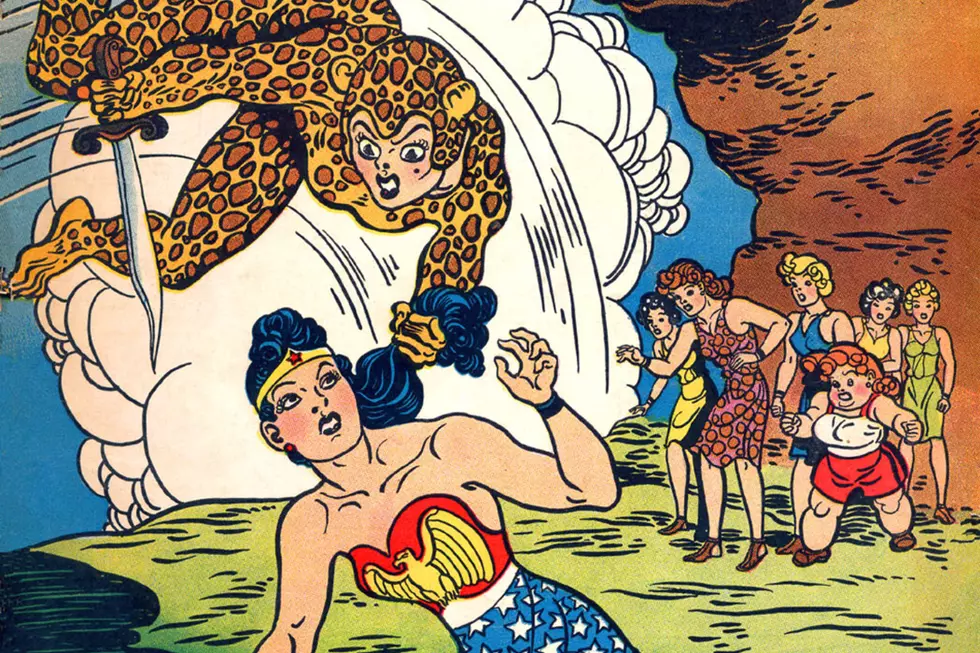
One Exclamation Point Isn’t Enough For Peter Bagge’s ‘Fire!! The Zora Neale Hurston Story’
Peter Bagge's particular cartooning style is immediately identifiable as his and his alone, signified by big expressive faces, seemingly boneless rubber limbs, hunched question mark-shaped postures, and such gag comic staples to underline emotions as surprise lines, anger-waves and floating hearts.
Despite a long, varied and successful career in comics, he's probably not the first creator anyone would expect to produce a thoroughly researched comic-format biography of American literary giant Zora Neale Hurston.
At least, he probably wouldn't have been a few years back. After his excellent and well-received 2013 Margaret Sanger biography Woman Rebel, a Hurston graphic biography seems like a perfectly natural, perhaps even ideal project for Bagge at this point in his career.
Fire!!: The Zora Neale Hurston Story takes its name from the title of a magazine Hurston and friends decided to create in reaction to the black literary and political establishment publications of the day. She arrives at it at the end of a great two-page, 12-panel sequence after a rent party that a professor leaves shortly after seeing that watermelon and fried chicken are being served.
It's a bravura sequence, demonstrating how Bagge's exaggerated style can be put in service of displaying outsized emotions, even when the anger and enthusiasm are prompted by heady issues like race, literature and an entire people's place in society: Hurston, at the center of a group of three men, shakes her fists and steams with rage; she crosses her eyes and imitates a chicken; she is goggle-eyed in shock at a friend's sudden decision to become a writer; she flexes her muscles, she narrows her eyes in a dotted line-producing stare, she throws her arms in the air and plants her fists on her hips. She proposes their magazine be called "Fire!!!" with three exclamation points, but when one of her group suggests that's a bit excessive she settles for two: "All I know is one isn't enough!"
Not only does this passage of the 72-page comics portion of the book demonstrate Bagge's skills, it also illustrates pretty perfectly Hurston's fiery, passionate, often even rash willingness to plow full-steam ahead into decisions; even after compromising her initial instincts a little, her decisions, actions and work all tended to be bigger, bolder and more outrageous than those of her fellow writers, creators and other peers. Which is in large part why people are still reading Hurston's writing so many years after her death.
Bagge's book's final page is set in 1973, after her death, when her unmarked grave is found, and a pair of women go to buy her a tombstone. It begins sometime in the late 1980s, when precocious little girl Zora meets a couple of white people driving through her all-black town in Florida. Born and raised in a small town with no exposure to white people, racism is something she was ignorant of as a child, and would gradually learn about as she experienced it first hand.
That and sexism are, of course, the twin oppositional -isms that she would encounter over and over throughout her life, in which she traveled far, far from her point of origin and into traditionally white, traditionally male roles and fields. Interestingly, as Bagge rarely misses an opportunity to point out, Hurston hardly defined herself or her work by those forces of opposition. In fact, as the magazine-naming sequence crystallizes, she struggled just as mightily against the expectations of fellow black writers and thinkers regarding what a black writer, male or female, should be writing or should be devoting their time to.
Hurston thoroughly embraced the right-what-you-know school of thought in her fiction, but that meant writing about the lives of poor black people in faraway, rural places, talking like the people she knew talked, and that rankled her defensive peers as much, if not more, than it did white America.
It's telling that Bagge, a cartoonist, actually tones down elements of Hurston's life, because to present them too accurately would prove too outrageous to, ironically, be considered realistic. In his two-page foreword, "Why Hurston?" Bagge apologizes for not trying to mimic her "inimitable way of writing and speaking" because, as he writes, "no one can imitate her, let alone some pasty-faced twenty-first century Northerner like myself." He also notes that he had to tone down her wardrobe, so as not to distract from the story: "She would be wearing, say, a Seminole Indian costume one day, and a men's three-piece suit the next, with no explanation given for either."
Bagge settles for drawing her almost exclusively in yellow dresses of one kind or another, although he leaves one of her most noteworthy accessories during a folklore collecting trip to the deep south: The holster in which she kept the pistol she bought and brought for her protection.
As remarkable as it is how much Hurston packed into her life, it's just as remarkable how much Bagge packs into such a short comic book about that life, as he covers her many and varied careers in chronicle fashion, rarely lingering on one for long. His comics biography of her is followed by 26-pages of prose notes, illustrated by photographs, offering context and detail to the preceding pages. This makes for a pretty full reading experience, as it allows Bagge to tell a story in the comics, and then make sure that anything important that he left out of that story is still in the book.
Fire!! isn't the best introduction to Hurston's life or work. Her own work speaks for itself, better than anyone else can advocate for it. But Bagge's latest comics biography of a remarkable woman is certainly the best cartoonist's introduction to Hurston's life and work, a well-made bridge from the comics medium to one of the 20th Century American masters of the prose medium, a real person whose real life proved too colorful and too outrageous to be a comic book character.
Fire!!: The Zora Neale Hurston Story by Peter Bagge is available now, published by Drawn & Quarterly.
More From ComicsAlliance









